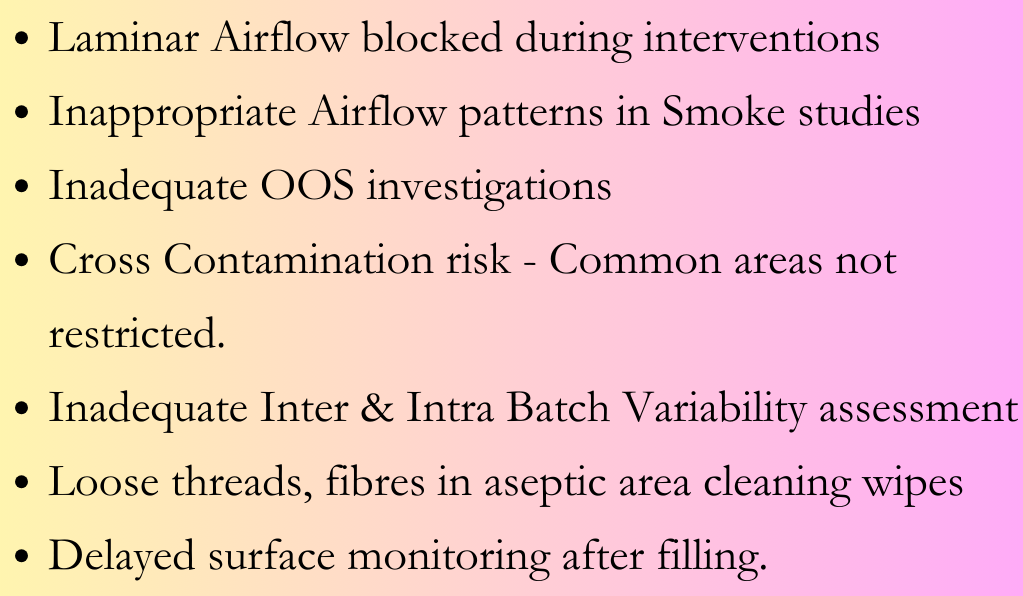
Aurobindo arm, Eugia Pharma Specialities facility at Bhiwadi, Rajasthan was issued USFDA 483 with seven observations following inspection in April -May 2024. The facility (FEI 3009883410) was inspected by USFDA investigators Justin A Boyd, Anastasia M Shields and Vaishali J Patel. The observations pertained to Inadequate operator practices, validations, cleaning practices and environment monitoring in aseptic areas, Inadequate failure investigations. The 483 also highlighted deficient containment control measures to prevent cross contamination between facilities and failure to establish required controls before introducing new manufacturing operations at the site.
USFDA 483 to Eugia, Bhiwadi in Rajasthan
Summary of observations in the USFDA 483 to Eugia Pharma Specialities, Bidadi in Rajasthan
- Operators’ practices are deficient to prevent microbial contamination of sterile products during aseptic operations. During several interventions within the RABS and the LAF, the laminar air flow is blocked by operators’ arm, upper torso. There were media fill study failure attributed to such operator behaviour. The interventions include:
- Assembling sterile vial tray
- Adjustment of fill weight
- Removing fallen vials
- Loading of stoppers, removing stopper jams
- Sampling of bulk canisters under LAF
- Filling of bulk API in canisters
- Aseptic processes are not adequately validated to prevent microbial contamination of sterile products.
- Sampling of bulk API canisters using sampling tool under LAF
- Smoke studies for Grade A Laminar flow are inadequate to demonstrate there is appropriate airflow during commercial aseptic operations like filling of bulk API in canisters, sampling of API in canisters, adjustment of fill weight.
- Investigations into failures / discrepancies are not thorough.
- Investigation into incident of turbid vial produced during aseptic simulation studies (was identified as caused due to organism Staphylococcus haemolyticus) was attributed to a non-routine intervention. Investigation did not evaluate other interventions performed during the same time frame. Also impact of such interventions in commercial production batches was not assessed.
- OOS investigations into OOS result of 3 batches of a sterile API for test by ICP-OES. OOS investigations into assay OOS of sterile API were inadequate. No hold time is established for bulk API stored in canisters before being filled into vials.
- Containment control measures are inadequate to prevent cross contamination
- Analytical Methods are not established to detect presence of cross contamination in products, facilities
- No monitoring mechanism and locations established to assess potential cross contamination
- No deactivating agent is established / validated for decontamination
- No procedures to restrict movement of personnel, equipment, documents, accessories through common areas like QC and microbiology labs, document issuance and storage area, meeting and conference rooms, canteen, common plant entry-exit area. There is no dedicated personnel for each facility. Maintenance and engineering tools are not dedicated for each facility.
- Appropriate statistical sampling plans are not established to assess inter and intra batch variability for process performance qualification studies and process validation studies.
- System for cleaning and disinfecting equipment in aseptic processing areas are deficient. The cleaning wipes used for cleaning have loose thread; there is no inspection procedure for cleaning wipes for loose threads and fibres.
- System for monitoring environment conditions in aseptic areas are deficient and not representative of environmental conditions at the time of filling; Observed occasions were sampling for surface monitoring was performed next day after completion of filling.





Leave a Comment
You must be logged in to post a comment.